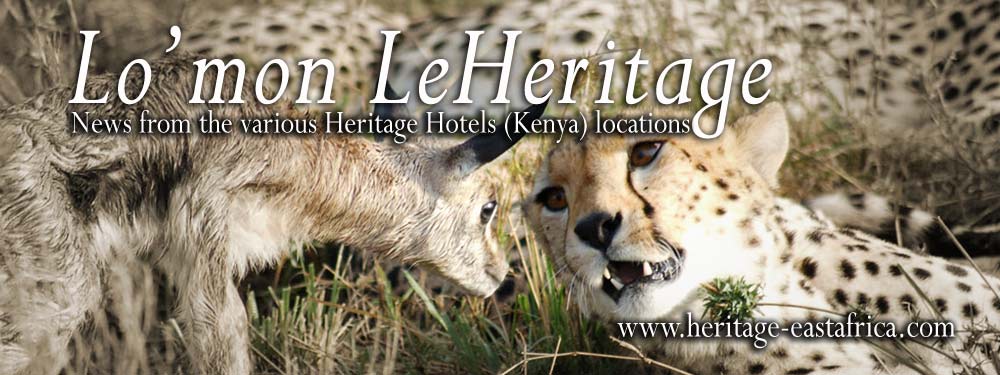The weather is super with
cool, clear mornings, becoming warmer in the afternoons with temperatures
hitting 27ºC. The sunsets are stunning - molten golden in the
horizon.
THE GREAT MIGRATION OF WILDEBEEST AND ZEBRAS
The migration is moving up north very fast. Herds of wildebeest and zebra are heading towards Mara Intrepids Camp. They can be seen around Maji-ya-Fisi (Hyena pool) up to Ngama Hills by the border of Serengeti.
It’s a good time to wait at the rivers to see them make the river crossing. There are many crossing points between the Talek River (even though the water level is quite low) to the Olkiombo Plain by Mara Intrepid.
The Mara weather is unique
and changes quickly. A week ago we had rain. But the water holes are dry and
therefore the herds are moving faster than expected in search of water to
quench their thirst because the grass they feed on is more like hay.
The zebra herds are further
west towards Paradise Crossing, ahead of the wildebeest. The zebra are near
Topi Plain enjoying the grass before the wildebeest arrive. The Paradise Crossing
is busy at the moment with zebras crossing to the west and into the Mara Triangle.
The water level in the Mara River
is not high enough for crocodiles to hunt. Hence the crossing today was
successful with no casualties. It’s not a very good time for the Nile
crocodiles that have been waiting for months for this opportunity but they have
to go hungry again.
PREDATORS SIGHTINGS
Predators
are having a good time for there is food all around them. The best time for
action is late in the evening and early in the morning. The rest of the day,
the cats rest in the bushes to avoid being seen by the prey and also it’s too
hot for them to do anything.
LIONS
The prides are healthy and
the cubs very playful.
The Olkeju-Ronkai pride of 11
is in the middle of Meta plain concealed by the tall grass, waiting for the
wildebeest. It’s hard to see the lions.
The Olkiombo pride is divided
in two groups, each living independently in the same territory. The bigger
pride that’s Notch’s favourite has twelve cubs and four lionesses. Notch loves
to be with cubs.
The second group of six has
one cub and five lionesses.
The Ridge pride of 12 is
still together with their sub-adult aged two and half years.
The Paradise pride of 11 has
three black-manned lions. They operate both sides of the Mara River.
The Marsh pride is also divided
into two. One group of nine has three lionesses; three cubs aged one year and
three males. They are at Topi plain. Two of the lionesses are mating. The other
group of twenty six is at Marsh. Scarface, the male lion is with them.
LEOPARDS
There are lots of leopard
sighting all along Talek River between Fig tree and Mara Intrepids Camp following
the wildebeest. A female with a cub was seen hunting a wildebeest calf. A male
leopard was also seen with a wildebeest kill two kilometers near Mara Intrepids
Camp.
In the west near Paradise
plain at Shamarta, two young leopard males were seen separately. One had an
impala kill and the other was with a buffalo kill. They were at the marshy section near the
albino hippo pool, both very calm and posing for photos.
Olive is a little confused
because the wildebeest are between the crossings in her territory. She can’t
make up her mind which one to hunt at.
CHEETAHS
The cheetahs have moved
towards the clear plains where the wildebeest have cleared the grass. This has made
it easier for them to hunt their preferred prey which is the Thomson and Grant
gazelles.
Have you booked your safaris? We have a few slots for the wildebeest migration at Mara Intrepids, which you can combine with a safari from Samburu, and then some sun at Lamu's most amorous hideaway, Kipungani Explorer.
Download our specials or contact us on sales@heritagehotels.co.ke.
Heritage Hotels (Kenya) manages two luxury camps in the Masai Mara - Mara Explorer and Mara Intrepids - in the confluence of the four game viewing areas of the Masai Mara. The camps are on the banks of the Talek River, with most tents spread along the banks. Report by John Parmsau. Pictures by John Parmasau & Ndeithi Kariuki ©Heritage Hotels Ltd, Kenya. http://www.heritage-eastafrica.com/






























